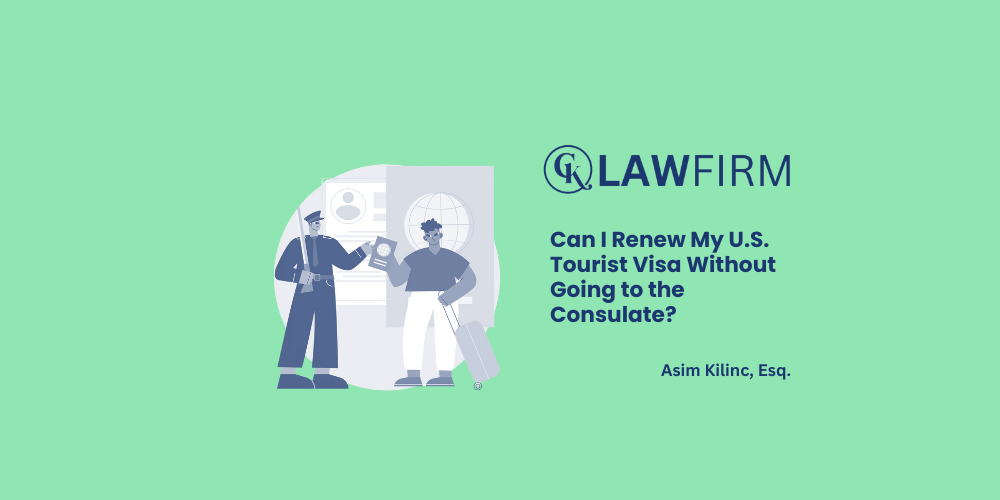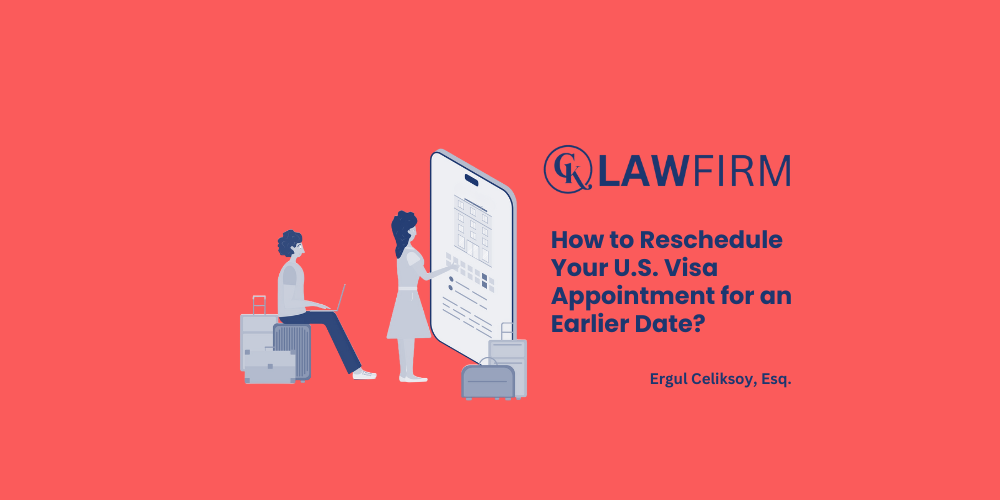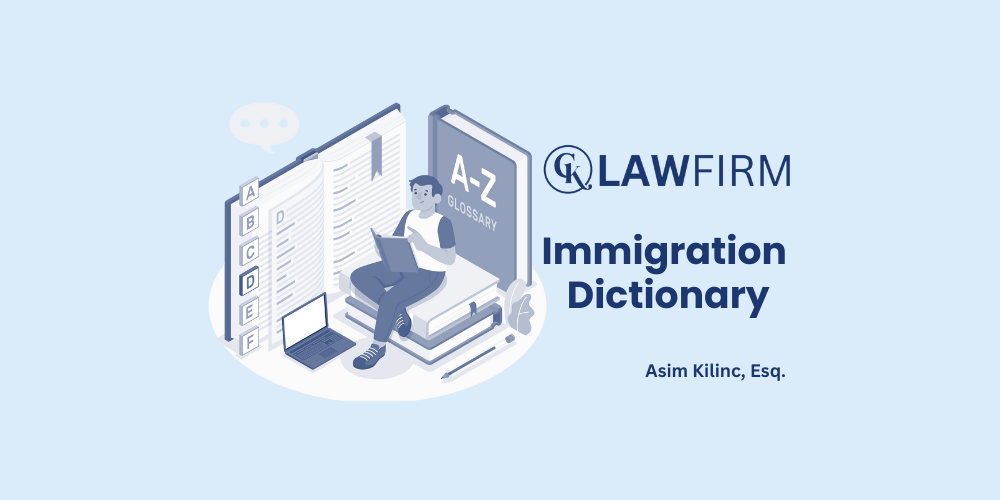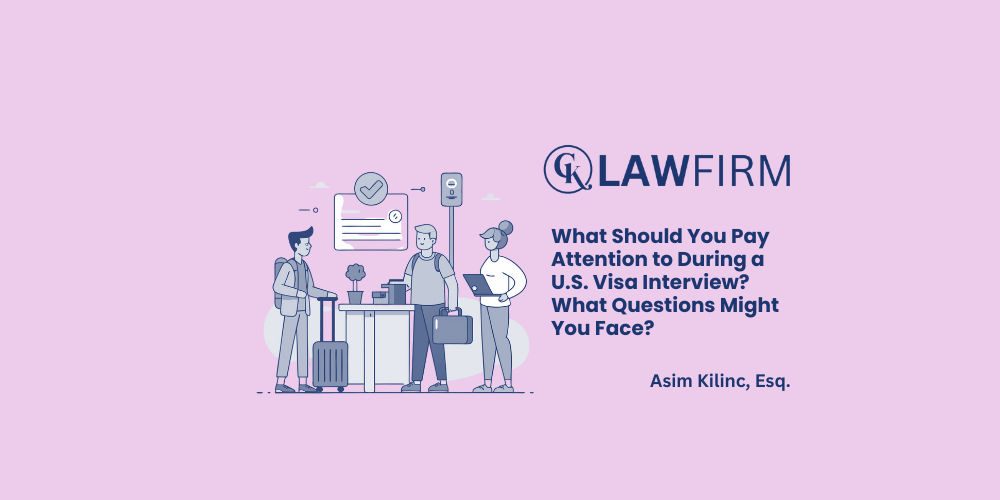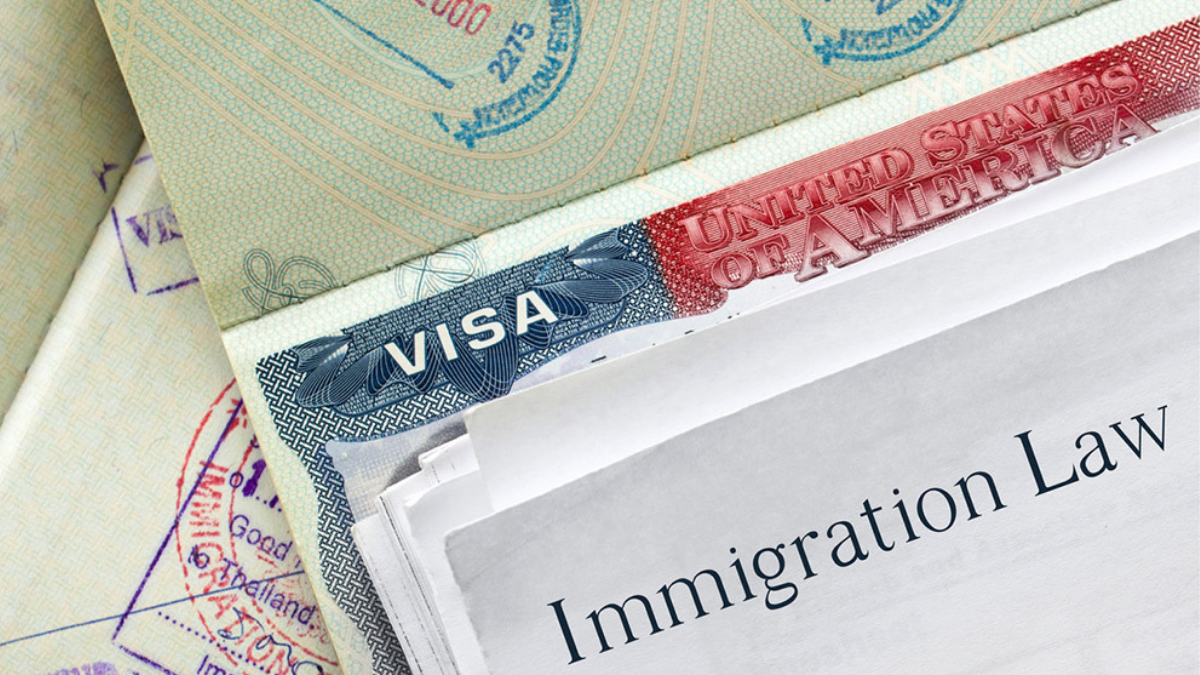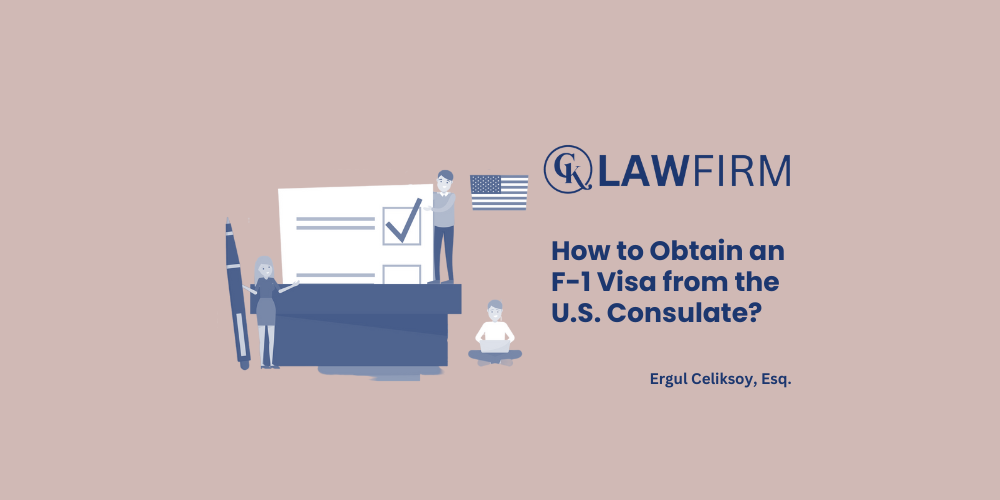Schedule an Appointment with Our Attorneys Now
By Asim Kilinc, Immigration Attorney at CK Law Firm
B1/B2 visas, the most preferred visa types for tourist and business trips to the United States (U.S.), are valid for a specific period. For individuals who frequently travel to the U.S., the expiration of this visa can pose a problem. Fortunately, U.S. visa holders can renew their visas without going to the consulate, provided they meet specific criteria. In this article, we will detail how you can renew your U.S. tourist visa without visiting the consulate and what to consider during the process:
- What is U.S. Tourist Visa Renewal?
- Who is Eligible for the Visa Renewal Waiver?
- How is the Visa Renewal Process Done?
- How Long Does the Visa Renewal Process Take?
- What Happens if My Visa Renewal Application is Denied?
- Frequently Asked Questions
If you have any questions beyond these topics, feel free to reach out via the comments section below this article, directly through LinkedIn, or via our CK Law Firm Immigration Attorney website!
1. What is U.S. Tourist Visa Renewal?
Before your U.S. tourist visa expires, you need to reapply to extend its validity. If you meet the necessary conditions, you can renew your visa by mail without having to visit the consulate. This is a significant advantage for frequent U.S. travelers as it allows you to avoid face-to-face interviews and long waiting times at the consulate.
The visa renewal process without visiting the consulate is a procedure implemented by the U.S. government, and only eligible applicants can benefit from this service. You can complete the process by applying online and mailing the required documents to the consulate.
2. Who is Eligible for the Visa Renewal Waiver?
The U.S. visa renewal waiver is available to individuals who meet specific criteria. To determine whether you’re eligible to renew your visa without going to the consulate, consider the following factors:
- Your Visa Must Have Expired or Be Near Expiration: Typically, you can apply for visa renewal within 48 months of your current visa’s expiration date.
- You Must Be Applying for the Same Visa Category: For instance, if you’re renewing a B1/B2 visa, you must apply for the same type of visa.
- You Must Not Have Violated U.S. Immigration Laws: You should have maintained your legal status during your stay in the U.S. and not engaged in any illegal activities.
- You Must Be Between 14-80 Years of Age: If you were between 14 and 80 years old when you last applied for a visa, you can benefit from this exemption.
- Your Last U.S. Visa Application Must Not Have Been Denied: It’s crucial that your previous U.S. visa application didn’t lead to any negative outcomes.
After evaluating whether you meet these criteria, you can proceed with your visa renewal application. However, it is important to check the U.S. consulate’s official website for the latest requirements before applying.
3. How is the Visa Renewal Process Done?
To complete the visa renewal process step by step, follow these procedures:
a) Fill Out the DS-160 Form
The first step in your visa renewal application is completing the DS-160 form online. This form forms the basis of U.S. visa applications and contains a wide range of details, from your personal information to travel plans. Review your information carefully and ensure that everything is complete.
- Important Note: After completing the form, keep a copy of the barcode. This document is an official part of your application and will be one of the documents you send later via mail.
b) Pay the Visa Application Fee
The visa application fee may vary depending on the type of visa you are applying for. Be sure to pay this fee during the application process. After making the online payment, do not forget to keep the payment receipt.
c) Prepare the Required Documents
You must send the following documents to the consulate with your application:
- A valid passport: Your current passport must be valid for at least six more months.
- A copy of your previous U.S. visa: Attach a copy of your expired or soon-to-expire U.S. visa.
- DS-160 Form: Include the barcode printout of the DS-160 form you filled out online.
- Biometric Photograph: Attach a 5×5 cm biometric photo taken within the last six months.
- Visa Fee Receipt: Include the official receipt of the visa application fee payment.
d) Send the Documents to the Consulate
Once you’ve prepared all your documents, mail them to the U.S. Consulate’s designated address. Your application will only be complete once the consulate receives your documents and begins the review process.
4. How Long Does the Visa Renewal Process Take?
The process of renewing a visa without going to the consulate usually takes a few weeks. It is recommended that you submit your application early based on your travel plans. Considering the mailing process and the time it takes to process the application, the entire procedure can be completed within 2 to 4 weeks.
5. What Happens if My Visa Renewal Application is Denied?
In some cases, after reviewing your application, the U.S. Consulate may ask you to come in for a face-to-face interview. This could be due to incomplete or inconsistent information in your application or for other reasons. If you’re called for an interview, you’ll need to follow the standard visa application procedure.
6. Frequently Asked Questions
a) Will the Visa Renewal Application Without Visiting the Consulate Be Successful?
If all the requirements are met, visa renewal applications without going to the consulate have a high success rate. However, each application is subject to review by the U.S. consulate, and the final decision always rests with consular officials.
b) What Should I Pay Attention to When Applying for Visa Renewal Without Visiting the Consulate?
Make sure all the information you provide is accurate and complete during the application. Be particularly careful when filling out the DS-160 form and avoid providing incorrect or incomplete information. Also, ensure your biometric photo is current and meets the application requirements.
c) Can I Apply for Visa Renewal if My Passport is About to Expire?
When applying for U.S. visa renewal, your passport must be valid for at least six months. If your passport is about to expire, it is recommended to renew it first. After renewing your passport, you can complete your visa application with the new passport number.
Conclusion
The U.S. tourist visa renewal process is straightforward when the correct steps are followed. If you meet the necessary conditions, you can renew your visa without going to the consulate and continue your travels to the U.S. without interruption. For detailed information and consulting services, you can contact us via cklawfirm.org, info@cklawfirm.org, or LinkedIn.
Who is Attorney Asım Kılınç?
Attorney Asım Kılınç is the co-founder of CK Law Firm and is recognized for his expertise in immigration law and U.S. asylum applications. Kılınç completed his Master’s degree at Southern Methodist University Dedman School of Law and is a member of the Missouri Bar Association, with a focus on U.S. immigration law.
Attorney Kılınç’s extensive knowledge and experience in immigration law have significantly contributed to CK Law Firm’s success in this field. He has actively participated in the preparation of over 1,000 cases, demonstrating his expertise in this area. By providing comprehensive and professional legal support to his clients, he helps them adapt to their new lives in the U.S.
Attorney Kılınç is also well-versed in U.S. asylum applications. He meticulously guides his clients through the process and ensures they receive the best legal advice. He provides top-quality service to clients in matters of citizenship, Green Card, work permits, and other immigration processes, supporting them from start to finish on their journey to U.S. citizenship.
Attorney Asım Kılınç, who solidifies CK Law Firm’s leadership in immigration law and U.S. asylum applications, offers reliable and effective legal consultancy services to clients, assisting them in building a new life in the U.S.
By Ergul Celiksoy, Immigration Attorney at CK Law Firm
Obtaining a U.S. visa can be a complex and time-consuming process for many applicants. One of the critical steps in this journey is securing an appointment for the visa interview. However, due to high demand, appointments are often scheduled far in advance, causing delays in travel plans. This can be particularly stressful for applicants who need to be in the U.S. by a specific date. Fortunately, there are some strategies and methods to help you reschedule your U.S. visa appointment to an earlier date. In this article, we will explain step-by-step how you can move your appointment forward:
- Expedited Appointment Request
- Regularly Monitor the Appointment System
- Complete the DS-160 Form Accurately
- Is it Possible to Pay for an Earlier Appointment?
If you have any questions regarding these topics, feel free to reach out through the comments section below, send me a message via LinkedIn, or contact us through the CK Law Firm Immigration Law Firm’s website!
1. Expedited Appointment Request
One of the most effective ways to move your U.S. visa appointment to an earlier date is by requesting an expedited appointment. U.S. Consulates provide this option to applicants in certain urgent situations. However, you must prove that you have a legitimate emergency to qualify for this request. U.S. Consulates typically accept expedited requests under the following circumstances:
a) Medical Emergencies
If a family member or close relative residing in the U.S. is undergoing urgent medical treatment, you can request an expedited visa appointment by providing documentation of the situation. You will need to submit medical reports or hospital documents explaining the urgency and the treatment being received.
b) Funerals or Serious Family Matters
In cases where a family member in the U.S. has passed away or is critically ill, you can apply for an expedited appointment. You will be required to submit funeral details or medical documents outlining the condition of your family member.
c) Academic and Educational Needs
Particularly for student visa applicants, if your school’s start date is approaching and your current appointment date is too late, you can request an expedited appointment. You will need to provide your acceptance letter and documents showing your education start date.
d) Business and Work Travel
If you need to attend an important business meeting, conference, or work-related event in the U.S., you may also qualify for an expedited appointment. In such cases, official letters from your employer, invitations, or documents showing the event’s date should be submitted with your request.
2. Regularly Monitor the Appointment System
If you cannot apply for an expedited appointment, another effective method is to regularly check the U.S. Consulate’s appointment system. Appointments can be canceled, or new slots may open up. It’s essential to check frequently to catch these opportunities.
a) What Time Should I Check?
To increase your chances, try checking the appointment system during certain times. Early in the morning and at the beginning of the week are ideal times to find new openings. Changes often occur as the workday starts, and canceled appointments might become available.
b) Steps for Rescheduling Your Appointment
Before canceling your existing appointment, ensure that you have secured a new, earlier date. It’s crucial not to cancel your current appointment until you’ve successfully rescheduled for a new date. Otherwise, you may lose your spot and struggle to find another one.
3. Complete the DS-160 Form Accurately
The DS-160 form is one of the most critical steps in the visa application process, as it lays the foundation for your application. Even if you want to reschedule your appointment, ensure that this form is filled out accurately and completely. Any mistakes or missing information could delay your process or complicate your request to move the appointment forward.
Important Considerations While Filling Out the Form:
- Personal Information: Ensure all personal details (name, address, date of birth, etc.) match your passport exactly.
- Purpose of Travel: Clearly state the reason for your visit to the U.S.
- Previous Travel History: Accurately provide details of your previous trips to the U.S. or other countries.
Once you have completed the DS-160 form, make sure to print the confirmation page to confirm that your visa application process has officially started.
4. Is It Possible to Pay for an Earlier Appointment?
In some countries, there is an option to pay additional fees to reschedule U.S. visa appointments for an earlier date. However, this option is not available in Turkey. The only way to move your appointment forward is by monitoring the appointment system or submitting an expedited request for urgent cases. Therefore, paying for an earlier appointment date is not applicable in Turkey.
Conclusion
The most reliable ways to reschedule your U.S. visa appointment for an earlier date are by submitting an expedited request or regularly checking the consulate’s appointment system. Ensure that your application documents are complete, your DS-160 form is filled out correctly, and the entire process is carefully managed. Especially if your travel date is approaching or you have an urgent situation, these methods can help you secure an earlier appointment. For detailed information and consultation, feel free to contact us through cklawfirm.org, info@cklawfirm.org, or LinkedIn.
Who is Attorney Ergül Çeliksoy?
Attorney Dr. Ergül Çeliksoy is a founding partner of CK Law Firm and also serves as an Assistant Professor of Law at the University of Nottingham. With extensive experience in U.S. immigration law, Dr. Çeliksoy completed a Master’s degree in international law and human rights law at the University of Nottingham in 2017, followed by a Ph.D. at the same university. His Ph.D., completed in 2022 at the University of Nottingham School of Law, marked a significant milestone in his academic career. Dr. Çeliksoy has published extensively in leading academic journals and is internationally recognized for his expertise in modern slavery, criminal justice, and criminal law. As a member of the California Bar, Dr. Çeliksoy offers exceptional service to his clients, particularly in U.S. immigration law cases. His expertise and experience in immigration law significantly contribute to CK Law Firm’s work in this area.
Dr. Çeliksoy provides comprehensive and strategic solutions to his clients in immigration law cases, helping secure their legal status in the U.S. His work on human rights and immigration processes, particularly in modern slavery and criminal law, effectively addresses the complex legal issues immigrants face. Dr. Çeliksoy reinforces CK Law Firm’s leadership in immigration law by offering reliable and effective legal consulting services to his clients, helping them build new lives in the United States.
By Asim Kilinc, Immigration Attorney at CK Law Firm
Whether you’ve arrived in the U.S. on an immigrant visa, a non-immigrant visa, or have entered through other means, navigating the immigration process can be daunting. There are many legal terms and concepts that can be confusing. To help you better understand these terms and ease your journey, we at CK Law Firm have created this comprehensive immigration law glossary. Our goal is to provide clear explanations to help you make informed decisions about your immigration status.
Immigration Law Glossary
A
- Adjustment of Status (AOS): The process of changing from a non-immigrant visa status to permanent resident status (Green Card) while staying in the U.S.
- Admissibility: Conditions determining whether a person is allowed to enter the U.S. or adjust their status.
- Affidavit of Support: A document an individual signs to accept financial responsibility for another person, usually required for family-based immigration.
- Alien: A non-citizen or foreign-born individual in the U.S.
- Appeal: A request for a higher authority to review a decision.
B
- B Visa: A non-immigrant visa for visitors entering the U.S. temporarily for business (B-1) or pleasure (B-2).
- Biometrics: Biological data, such as fingerprints and photographs, collected for background checks.
- Border Crossing Card: A document allowing Mexican citizens to cross into the U.S. for short visits.
C
- Cancellation of Removal: A form of relief allowing certain immigrants in removal proceedings to apply for a Green Card.
- Conditional Resident: A person granted permanent residence on a conditional basis, typically for two years, often through marriage.
- Consular Processing: Applying for a visa at a U.S. embassy or consulate outside the U.S.
D
- Deportation: The formal removal of an alien from the U.S. when they have been found removable for violating immigration laws.
- Diversity Visa Lottery: A program providing a limited number of visas annually to people from countries with low rates of immigration to the U.S.
- DACA (Deferred Action for Childhood Arrivals): A program allowing certain individuals who came to the U.S. as children to receive a renewable two-year period of deferred action from deportation and become eligible for a work permit.
E
- Employment Authorization Document (EAD): A document allowing non-citizens to work in the U.S.
- EB Visa: Employment-based immigration visas, categorized into five preference levels (EB-1 through EB-5).
- Expedited Removal: The quick removal of certain inadmissible aliens without a hearing.
F
- F Visa: Non-immigrant student visas (F-1 for academic students, F-2 for dependents, and F-3 for border commuters).
- Form I-485: The application form for Adjustment of Status to become a permanent resident.
G
- Green Card: Informal term for a Permanent Resident Card, which allows an individual to live and work permanently in the U.S.
- Grounds of Inadmissibility: Reasons an individual can be denied entry to the U.S. or adjustment of status.
H
- H Visa: Temporary work visas (e.g., H-1B for specialty occupations, H-2A for agricultural workers, H-2B for non-agricultural workers).
I
- Immigrant Visa: A visa allowing a person to live permanently in the U.S.
- I-94 Form: A form issued to visitors at the time of entry, indicating their visa status and authorized period of stay.
- Illegal Immigrant: A person who has entered the U.S. without proper documentation or has overstayed their visa.
- Immigration and Customs Enforcement (ICE): The federal agency responsible for enforcing immigration laws and investigating illegal immigration activities.
J
- J Visa: Exchange visitor visas for individuals approved to participate in exchange programs (e.g., for study, research, or teaching).
K
- K Visa: Non-immigrant visas for fiancés (K-1) and spouses (K-3) of U.S. citizens.
- K-2/K-4 Visa: Non-immigrant visas for children of K-1/K-3 visa holders.
L
- L Visa: Intra-company transferee visas for employees of international companies being transferred to the U.S.
- Lawful Permanent Resident (LPR): An individual who has been granted the right to live permanently in the U.S.
M
- M Visa: Non-immigrant visas for vocational students.
- Migrant: A person who moves from one country to another, typically for work or better living conditions.
N
- Naturalization: The process by which a foreign citizen becomes a U.S. citizen.
- Non-immigrant Visa: A visa for a temporary stay in the U.S. for purposes such as tourism, business, or education.
O
- O Visa: Non-immigrant visas for individuals with extraordinary ability in sciences, arts, education, business, or athletics.
- Overstay: Staying in the U.S. longer than the authorized period of stay.
P
- Parole: Temporary permission to enter or remain in the U.S. granted by immigration authorities.
- Petition: A formal request to USCIS for a visa or change of status.
- Priority Date: The date an immigrant petition is filed, used to determine visa availability.
Q
- Quota: A limit on the number of visas issued each year in certain categories.
- Qualifying Relative: A family member whose relationship to the immigrant is the basis for an immigration benefit.
R
- Refugee: A person who has been forced to flee their country due to persecution or a well-founded fear of persecution.
- Removal Proceedings: The legal process to determine whether an individual should be removed (deported) from the U.S.
S
- Sponsor: A person who takes responsibility for another individual’s application for an immigration benefit.
- Status: The visa category or immigration classification that defines a person’s rights and responsibilities in the U.S.
T
- Temporary Protected Status (TPS): A temporary immigration status for nationals of certain countries experiencing problems that make it unsafe to return.
- Travel Document: A document allowing travel outside the U.S. and re-entry, such as a re-entry permit or refugee travel document.
U
- U Visa: Non-immigrant visas for victims of certain crimes who assist law enforcement in investigating or prosecuting those crimes.
- USCIS: U.S. Citizenship and Immigration Services, the government agency that oversees lawful immigration to the U.S.
V
- Visa: A document allowing a person to apply for entry to the U.S.
- Visa Waiver Program (VWP): A program allowing citizens of certain countries to travel to the U.S. without a visa for stays of 90 days or less.
W
- Waiver: An official document granting forgiveness for certain immigration violations or grounds of inadmissibility.
Y
- Youth: Special immigrant juvenile status (SIJS) for certain undocumented minors who are unable to reunite with one or both parents due to abuse, neglect, or abandonment.
Z
- Zero Tolerance Policy: A policy that refers to the enforcement of all immigration laws without exception.
Conclusion
Navigating the U.S. immigration system can be challenging, but understanding these key terms can make the process easier. If you need personalized assistance with your immigration journey, CK Law Firm is here to help. Contact us today for expert legal advice and support.
By Asim Kilinc, Immigration Attorney at CK Law Firm
The U.S. visa interview is one of the most critical stages of the visa application process. During this interview, the consular officer will ask questions to understand the purpose of your trip and how long you plan to stay in the U.S. The officer will also try to determine whether you are visiting the U.S. for a legitimate, temporary reason. Therefore, preparing properly for the interview is crucial for a successful outcome. Here’s a detailed guide on what to pay attention to during a U.S. visa interview and the types of questions you may encounter:
- What is a U.S. Visa Interview, and Why is it Conducted?
- Preparing for the Interview: What Should You Do?
- Potential Questions You May Face in a U.S. Visa Interview
- Tips for the U.S. Visa Interview
If you have further questions about the topic, please don’t hesitate to contact me through the comments section below, send me a message on LinkedIn, or reach out via CK Law Firm’s website, where I am a co-founder.
What is a U.S. Visa Interview, and Why is it Conducted?
Foreign nationals who wish to travel to the U.S. must participate in a visa interview, depending on the type of visa they are applying for. The primary goal of the interview is to assess whether the applicant’s purpose of travel and length of stay in the U.S. are legitimate. Visa officers also consider whether the applicant intends to comply with U.S. regulations and return to their home country after the authorized stay period ends.
The questions asked during the interview may vary depending on the visa type; however, the fundamental purpose of all visa interviews is to ensure that the applicant will not misuse the visa. Therefore, the answers you provide during the interview are critical. Answering questions clearly and honestly will significantly improve the chances of a successful application.
Preparing for the Interview: What Should You Do?
a) Your Appearance and Demeanor
From the very beginning of the interview, you need to make a positive impression on the consular officer. Ensure your attire is neat and professional. Dress as if you were going to a job interview—stylish, orderly, and clean. Staying calm and confidently answering questions will create a positive impression. Try to control any nervousness by taking deep breaths and relaxing.
b) Document Preparation
Make sure all your documents are complete and accurate for the U.S. visa interview. The documents you should bring to the interview include:
- Passport: A valid passport covering the duration of your stay.
- DS-160 Confirmation: A completed DS-160 form is a critical part of the U.S. visa application process, and you must bring the confirmation printout.
- Visa Appointment Confirmation: A document confirming your appointment date and time.
- Financial Documents: Bank statements, pay stubs, or a sponsor letter proving that you can cover your expenses during your stay in the U.S.
- Educational or Employment Documents: If you are a student, bring a student certificate from your school. If employed, bring a letter from your employer and your pay stubs.
- Invitation Letter (if applicable): If you are traveling for purposes such as a job interview, education, or conference, present the relevant invitation letter.
Organizing your documents and having them easily accessible during the interview will make the process smoother.
c) Practice
Rehearsing possible questions before the visa interview will be highly beneficial. Based on previous interview experiences, prepare yourself for frequently asked questions. Keep your answers concise, genuine, and straightforward.
Potential Questions You May Face in a U.S. Visa Interview
The questions asked during the U.S. visa interview can vary depending on the type of visa you are applying for, the purpose of your travel, and your personal circumstances. However, you are likely to encounter questions of the following types:
a) What is the Purpose of Your Trip?
This is almost guaranteed to be asked during the interview. You should clearly explain the purpose of your trip to the U.S. Whether it is for tourism, business, family visit, or education, state your purpose and the duration of your stay clearly. Think through your travel plans before the interview and prepare for possible questions.
Sample Answer: “I am traveling to the U.S. for tourism. My plan is to spend a week in New York, visiting the city’s historical and cultural landmarks.”
b) Who Will You Stay With, and Where Will You Stay in the U.S.?
Questions about your accommodation and contacts in the U.S. are also common. If you plan to stay in a hotel, you may need to provide reservation details. If you plan to stay with someone you know, clearly explain your relationship with them and where you will be staying.
Sample Answer: “I’ve booked a room at XYZ Hotel in New York, where I’ll be staying during my trip.”
c) What are Your Financial Resources for the Trip?
You will be expected to show how you will cover your expenses for accommodation, transportation, and other costs in the U.S. Bank statements, pay stubs, sponsor letters, or scholarship documents can be presented to prove your financial status. This is one of the most critical questions in the interview, as financial capability can directly impact the visa officer’s decision.
Sample Answer: “I have sufficient savings for my trip. I am providing my last six months of bank statements and pay stubs.”
d) Have You Been to the U.S. Before?
If you have visited the U.S. before, the consular officer may ask for details. You should provide clear information about your stay, the purpose of your trip, and your return. If you haven’t visited the U.S. before, respond honestly.
Sample Answer: “Yes, I visited the U.S. for business in 2019 and stayed for one week.”
e) Do You Plan to Return to Your Home Country?
The primary purpose of U.S. visa interviews is to ensure that you plan to visit the U.S. temporarily and do not intend to remain in the country illegally. The consular officer will assess the strength of your ties to your home country. By demonstrating strong educational, professional, or familial connections, you can prove your intention to return.
Sample Answer: “I plan to return to my job and family after my trip. I have ongoing employment and education commitments here.”
Tips for the U.S. Visa Interview
- Keep Your Answers Short and to the Point: Visa officers expect clear and direct answers. Avoid misleading or unnecessary details. The more straightforward you are, the better impression you will make.
- Practice Your English: The interview is typically conducted in English. Ensure your basic English skills are sufficient, and practice short conversations to prepare for the interview.
- Provide Accurate Information: Make sure the information you provide during the interview is consistent with your DS-160 form and other documents. Providing conflicting or incorrect information can lead to your visa application being denied.
- Stay Calm and Confident: To avoid appearing nervous, answer calmly and in a controlled manner. A confident attitude will leave a positive impression.
Conclusion
The U.S. visa interview requires preparation and attention. Being ready for potential questions, presenting complete documentation, and providing accurate information will increase the likelihood of your visa application being approved. Clearly defining the purpose of your trip and confidently conveying this during the interview are key ways to persuade the consular officer. To succeed in the interview, it is essential to carefully follow every step of the visa process and be thoroughly prepared. For detailed information and consultancy services, feel free to reach us at cklawfirm.org, via email at info@cklawfirm.org, or through LinkedIn.
Who is Attorney Asım Kılınç?
Attorney Asım Kılınç is the co-founder of CK Law Firm and is recognized for his expertise in immigration law and U.S. asylum applications. Kılınç completed his Master’s degree at Southern Methodist University Dedman School of Law and is a member of the Missouri Bar Association, with a focus on U.S. immigration law.
Attorney Kılınç’s extensive knowledge and experience in immigration law have significantly contributed to CK Law Firm’s success in this field. He has actively participated in the preparation of over 1,000 cases, demonstrating his expertise in this area. By providing comprehensive and professional legal support to his clients, he helps them adapt to their new lives in the U.S.
Attorney Kılınç is also well-versed in U.S. asylum applications. He meticulously guides his clients through the process and ensures they receive the best legal advice. He provides top-quality service to clients in matters of citizenship, Green Card, work permits, and other immigration processes, supporting them from start to finish on their journey to U.S. citizenship.
Attorney Asım Kılınç, who solidifies CK Law Firm’s leadership in immigration law and U.S. asylum applications, offers reliable and effective legal consultancy services to clients, assisting them in building a new life in the U.S.
By Ozlem Kara, Content Editor at CK Law Firm
On August 27, 2024, the U.S. Department of State (DOS) announced that all available visas for fiscal year (FY) 2024 under the employment-based first preference (EB-1) and fourth preference (EB-4) categories have been allocated. Earlier, on August 16, 2024, DOS confirmed that all visas in the EB-3, EW (Other Workers), and unreserved EB-5 categories had also been issued.
For the EB-1 category, DOS explained that “fully utilizing these visas supports legitimate travel for individuals with extraordinary abilities, nationally or internationally acclaimed professionals, as well as distinguished professors, researchers, and high-level executives and managers from multinational corporations.” In reference to the EB-4 category, DOS highlighted that maximizing the visa allocation “aids in facilitating travel for a diverse group of special immigrants, including religious workers, special immigrant juveniles, certain U.S. government employees, retirees of international organizations, and international broadcasting personnel, among others.”
The visa limits will reset with the start of the new federal fiscal year on October 1, 2024. After this date, U.S. embassies and consulates will be able to continue issuing immigrant visas to eligible applicants in these categories. Additionally, USCIS will also resume processing and approving Adjustment of Status applications (Form I-485) for qualified applicants beginning on October 1, 2024.
By Ergul Celiksoy, Immigration Attorney at CK Law Firm
For foreign students wishing to study in the U.S., the F-1 student visa is one of the most common types. In this article, we will cover the steps required to obtain an F-1 visa, the importance of the I-20 form, rights for family members (spouse and children) related to the visa, and how long the application process may take.
- What is an F-1 Visa?
- Requirements to Obtain an F-1 Visa
- F-1 Visa Application Conditions
- Can Spouses and Children Obtain F-2 Visas?
- How Long Does It Take to Get an F-1 Visa?
- Other Important Points for Visa Applications
If you have any questions other than those mentioned here, please feel free to leave a comment below this article, send me a message directly on LinkedIn, or contact me through CK Law Firm’s website, where I am one of the co-founders.
What is an F-1 Visa?
The F-1 visa is issued to students wishing to study full-time in the U.S. It applies to students accepted by an approved educational institution (such as a college, university, or language school). The visa allows students to stay temporarily in the U.S. and reside there during their studies.
Requirements to Obtain an F-1 Visa
To obtain an F-1 visa, the following steps must be followed:
Get Accepted to an Approved U.S. Educational Institution:
To apply for an F-1 visa, you must first be accepted by a school in the U.S. The school you apply to must be certified by the SEVP (Student and Exchange Visitor Program).
What is the I-20 Form, and Why is It Important?
After being accepted by the school, the institution will provide you with an I-20 form. This form serves as an acceptance letter and will be used throughout your education in the U.S. It includes details of your program and financial situation.By submitting the I-20 form, your registration in SEVIS (Student and Exchange Visitor Information System) is created, marking the first step in the visa application process.
Pay the SEVIS Fee:
After receiving the I-20 form, you must pay the SEVIS fee. This fee is essential for your registration in the U.S. immigration system and is a critical step in applying for an F-1 visa.
Complete the DS-160 Form:
To apply for an F-1 visa, you need to fill out the online DS-160 visa application form. This form is used by the consulate to gather information about you. After completing the form, you can continue with the application process by submitting the required documents.
Attend the Consular Interview:
After preparing the DS-160 form and other documents, you must schedule an interview at the U.S. consulate. During the interview, you will be asked about your study plans, financial situation, and how you will support yourself in the U.S. You must bring your I-20 form, passport, and other necessary documents to the interview.
F-1 Visa Application Conditions
To be eligible for an F-1 visa, students must meet the following requirements:
- Full-Time Enrollment: F-1 visas are only issued to full-time students.
- Proof of Financial Support: You must present documents proving that you can cover your expenses while in the U.S.
- Intent to Study: During the consular interview, you must prove that you are traveling to the U.S. solely for educational purposes.
- Valid Passport: Your passport must be valid for at least six months beyond your intended date of entry to the U.S.
Can Spouses and Children Obtain F-2 Visas?
Spouses and unmarried children under the age of 21 of F-1 visa holders can enter the U.S. on F-2 visas. However, F-2 visa holders are not allowed to work in the U.S. and cannot enroll in full-time studies, though children can attend K-12 schools.
How Long Does It Take to Get an F-1 Visa?
The processing time for an F-1 visa application depends on the country where the application is submitted and the consulate’s workload. Generally, visa applications can take anywhere from a few weeks to a few months to be processed. Therefore, it is advisable to start the application process as early as possible.
Other Important Points for Visa Applications
- Apply Early: Complete your visa application and schedule your interview well before the academic year begins.
- Submit Complete Documentation: Ensure that you have all required documents, such as your passport, I-20 form, SEVIS fee receipt, and financial documents.
- Be Prepared for Visa Denial: Sometimes, visa applications may be denied for various reasons. If this happens, you can reapply after understanding the reasons for the denial.
Conclusion
Obtaining an F-1 visa is an essential process for international students wishing to study in the U.S. Getting the I-20 form and preparing for the consular interview are critical steps. Students must also prove their financial status and demonstrate their intent to study in the U.S. throughout the visa process. Careful attention to these steps and the submission of complete documentation are key to a successful visa application. For detailed information and consultancy services, feel free to contact us at cklawfirm.org, via email at info@cklawfirm.org, or through LinkedIn.
Who is Attorney Ergül Çeliksoy?
Attorney Dr. Ergül Çeliksoy is a founding partner of CK Law Firm and also serves as an Assistant Professor of Law at the University of Nottingham. With extensive experience in U.S. immigration law, Dr. Çeliksoy completed a Master’s degree in international law and human rights law at the University of Nottingham in 2017, followed by a Ph.D. at the same university. His Ph.D., completed in 2022 at the University of Nottingham School of Law, marked a significant milestone in his academic career. Dr. Çeliksoy has published extensively in leading academic journals and is internationally recognized for his expertise in modern slavery, criminal justice, and criminal law. As a member of the California Bar, Dr. Çeliksoy offers exceptional service to his clients, particularly in U.S. immigration law cases. His expertise and experience in immigration law significantly contribute to CK Law Firm’s work in this area.
Dr. Çeliksoy provides comprehensive and strategic solutions to his clients in immigration law cases, helping secure their legal status in the U.S. His work on human rights and immigration processes, particularly in modern slavery and criminal law, effectively addresses the complex legal issues immigrants face. Dr. Çeliksoy reinforces CK Law Firm’s leadership in immigration law by offering reliable and effective legal consulting services to his clients, helping them build new lives in the United States.
Subscribe to Our Newsletter
Subscribe to our newsletter to stay informed about the latest announcements and articles written by our attorneys on U.S. immigration processes.
Sobre Nosotros
Contáctanos
+1 (945) 527- 23 22
Correo electrónico
info@cklawfirm.org
Dirección
2800 Regal Rd #102, Plano, TX 75075
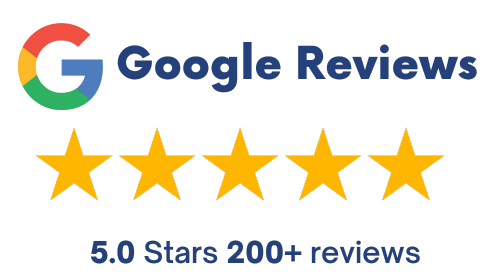
All Rights Reserved by CK Law Firm.


